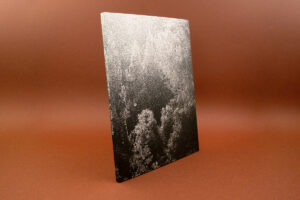YOUR CART
- No products in the cart.
Subtotal:
€ 0

Concept and photography:
Pablo Cabado
Text:
Diego Castelfranco
Translations:
Jorge Salvetti
Design:
Carel Fransen
Lithography:
Murat Cetin (MAS Matbaa)
Print and binding:
MAS Matbaa (TR)
During most of World War II, Argentina maintained close ties with Germany and remained neutral for its hundreds of thousands of immigrants living in the country. After the war, it became the main safe haven for fleeing Germans, while President Juan Perón ordered to secretly smuggle in those with particular military and technological expertise that could help his country forward. One of these people was Austrian-born German scientist Ronald Richter.
Convincing Perón about the feasibility of generating unlimited energy through nuclear fusion, Richter managed to receive massive funding to build an experimental fusion reactor on Huemul Island, near the town of San Carlos the Bariloche in Patagonia. After two years of construction, Perón publicly announced that Richter’s experiments had been successful, adding that it all came down to “lighting up artificial suns on the Earth.” Worldwide interest and significant scepticism followed, and after a year of reporters and other scientists visiting the island to try to investigate the unsupported claims, only to be denied access or explanation, the truth came out about Richter’s deceptions and Project Huemul came to an abrupt end.
With the strange history of power and intrigue in the back of his mind, it was Huemul Island, among the many small islands in Nahuel Huapi Lake, that attracted the attention of Pablo Cabado (AR). In Little Suns on Earth, this history becomes tangible with Cabado’s tritone photographs depicting a slow exploration of the deserted island, compiled from his many trips over a period of six years. Overgrown tracks, ruins of buildings, defaced walls with swastikas, bullets and electrical elements scattered around the area are the only remnants left of the secret development that took place.
The visual narrative is coupled with an illustrated essay by historian Diego Castelfranco, comprehensively elaborating on the strange and monumental history of this scientific autocracy, and the dream that was never attained.
Pablo Cabado is a photographer based in Buenos Aires. His work has been exhibited in individual and collective exhibitions in the United States, France, Italy, Cuba, Peru, Mexico, Netherlands. Among the distinctions he has received are: Infinity Award, Young Photographer of the Year at the International Center of Photography, ICP New York; Mother Jones Award, San Francisco; Antorchas Foundation Fellow, Buenos Aires; National Endowment for the Arts, Buenos Aires; Grand Prize of Honor from the National Salon of Visual Arts, Buenos Aires; Klemm Acquisition Award, Buenos Aires and the John Simon Guggenheim Fellowship, New York. He has published the books Laminares, Cuba años 90 (1998); 37*57’5″S 57*34’47″W (2008); Psyche (2017); Little Suns on Earth (2023). During the year 2018 the book Psyche was a finalist for the Anamorphosis Prize in New York City. His work is part of private collections and museums in Latin America and the United States. As independent curator he has organized the exhibitions, The Dark West by Bryan Schutmaat; Mundo Fútbol collective exhibition with Vik Muñiz, Graciela Iturbide, Carlos Herrera, Stefan Ruiz, Noah Addis among others; Wonder of the World by Thomas Locke Hobbs; The Shibayamas by Giancarlo Shibayama. Since 2016 he has directed the independent editorial project photogramas.
“Made in various digital and analog formats, Cabado’s images put into perspective the brevity and misfortune of the Huemul project but without reducing them to mere illustrations of the text (which is necessary to appreciate the picture’s intricacies fully). In fact, their best quality is how, aided by their rich tonality, the pictures avoid screaming a specific message at the viewer, creating instead an intense aesthetic experience that suggests how geological time will always have the upper hand.” (Arturo Soto)